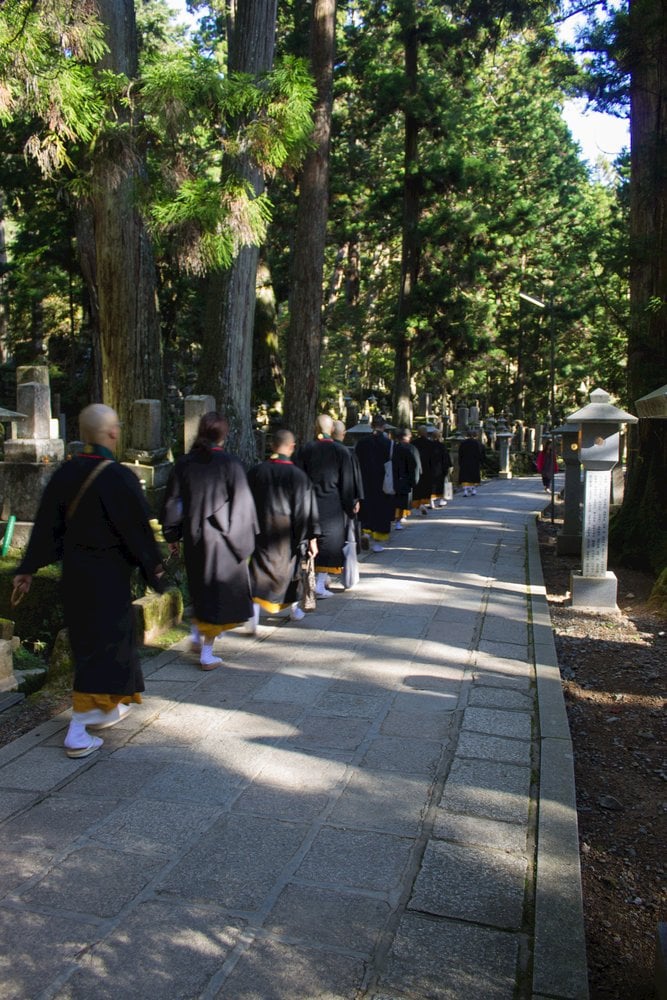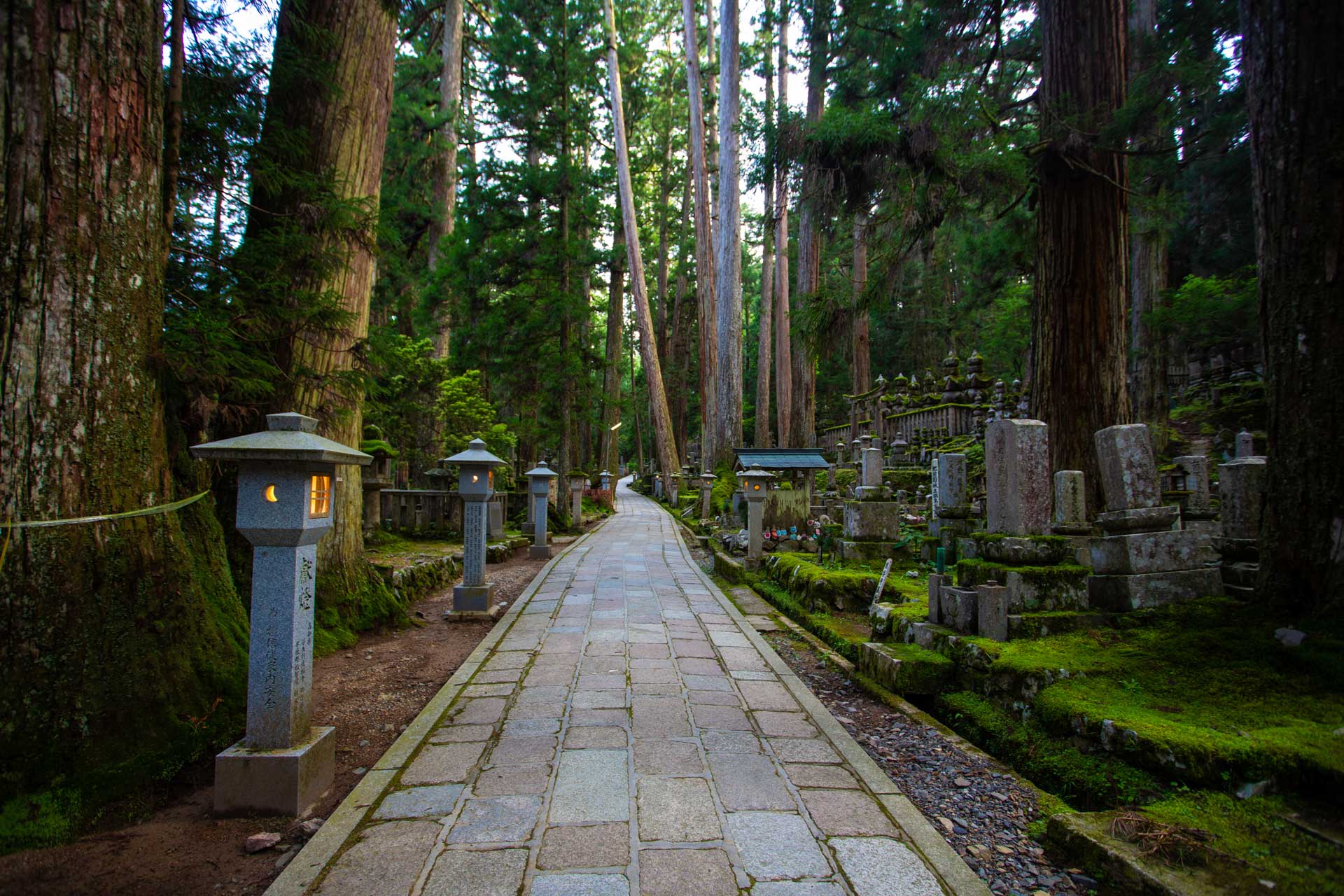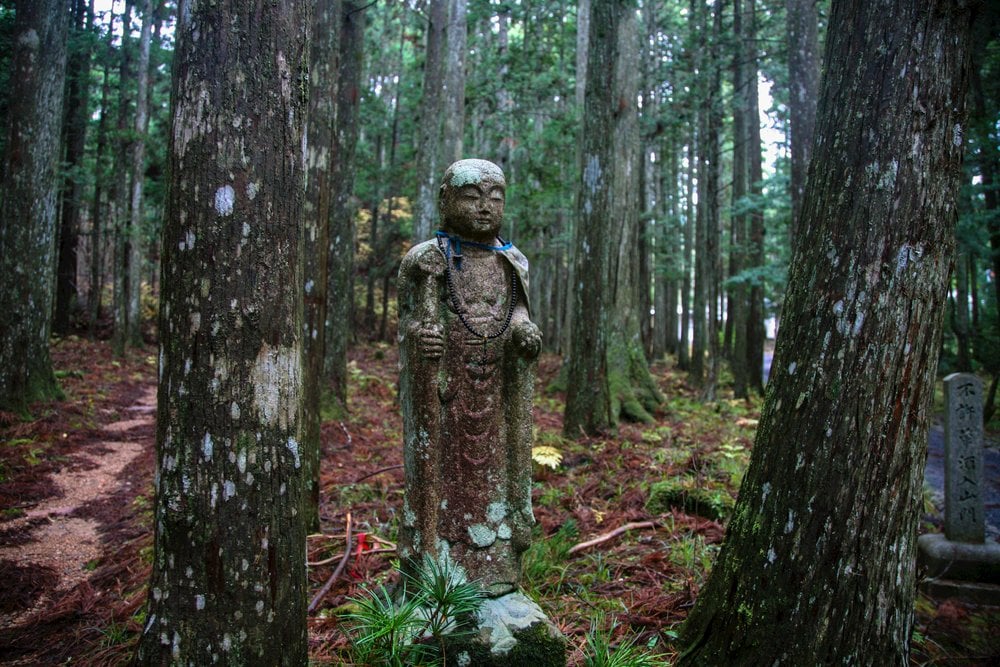Okunoin Cemetery on Mount Koya
In Japan it is said that you are born Shintoist but die Buddhist. This is evidenced in practice as many events celebrating life are conducted at shrines, while rites for the afterlife are performed at temples. In Buddhism, a spirit is considered a living being that is still present in the family home even after passing—where Japanese families with room to spare will have a traditional Buddhist altar in their homes. This alter serves as a residence for those who have passed where they continue to be treated as living beings, receiving morning greetings and food.
 It is believed that Japan chose Buddhism as the preferred funeral rite due to its more positive image of life after death. However, the truth is that cremation, a uniquely Buddhist ritual, became mandatory during the Showa era to conserve limited space. The last rites performed by a Buddhist monk actually take inspiration from Shinto rituals, as Japan’s indigenous religion stresses the importance of an afterlife more than Buddhism does.
It is believed that Japan chose Buddhism as the preferred funeral rite due to its more positive image of life after death. However, the truth is that cremation, a uniquely Buddhist ritual, became mandatory during the Showa era to conserve limited space. The last rites performed by a Buddhist monk actually take inspiration from Shinto rituals, as Japan’s indigenous religion stresses the importance of an afterlife more than Buddhism does.
The Shingon (esoteric) sect of Buddhism that resides on Mount Koya has a succinct view of those who have passed, wherein their graveyard Okunoin is not home to the dead, but waiting spirits. Buddhism doesn’t consider the body and the spirit to be separate, but as one entity intertwined to form a complex individual. The bridge to Okunoin serves as a boundary between worlds, and the cedar trees lining the path seem to open a barrier that welcomes you into the spirit world.
Traditionally, a Japanese grave consists of only a headstone and a collection of wooden sticks engraved with the posthumous Buddhist names belonging to the family. These headstones have a compartment to store the ashes of the deceased and a dedicated area for flowers, incense and the family seal. As such, a grave is considered a peaceful last resting place with members of the family visiting to routinely clean the headstone and leave drinks or snacks.

Venture deep into Okunoin and you will encounter many different graves, some that don’t even match any of the previous descriptions. This is because there are more than 200,000 different graves gathered around the mausoleum of the founder of Shingon Buddhism, Lord Kukai (known posthumously as Kobo Daishi). Mount Koya’s temple complex is another creation of Kukai, to serve as the centre of Shingon Buddhism and as a retreat from worldly affairs.
The spectacular growth of Okunoin is attributed to his massive spiritual influence, inspiring many from all over Japan to request that their remains be placed as close to the mausoleum as possible. To the Shingon Buddhist sect, Kukai has not passed on but is in a state of eternal meditation. Food is offered to him every day and certain monks will enter the mausoleum once a year to trim his hair and change his clothing.
While Kukai’s mausoleum is considered to be the most important location in the graveyard, there are some other interesting artifacts to be found in Okunoin. The best time to learn about the stories surrounding this mystical final resting place is at night during one of the special tours offered by resident monks, where the lit lanterns at dusk really make it feel as though you have stepped into the home of spirits. There, your guide will teach you about the cemetery’s famous superstitions and otherworldly objects, such as the Miroku Stone, a large stone at the centre of Okunoin that judges your sins--heavier for the sinful and light for the righteous, challengers must attempt to lift it with just one hand.

It is interesting to note that not only monks are buried here. In fact, anyone regardless of background is permitted a final resting place on the mountain. Still, if eternity is too big of a commitment for now, the Shingon Buddhists of Mount Koya run various temple retreats known as Shukubo that give visitors a glimpse into what life is like on Mount Koya. Each temple has its own charm, but what stays the same is the spiritual experience. Entering the mountain and seeing the light shine through the thick forest canopy on the mossy ground really makes you feel like you have been transported to a different world.
One of the core beliefs of Shingon Buddhism is a love of present life and a search for the truth. Being in the presence of veneered spirits brings inspiration and knowledge to celebrate life and understand its mysteries. Shingon in Japanese means ‘true word’, because it challenges its followers to get closer to the unwritten eternal wisdom of Buddha. Thus, a visit to Mount Koya allows you to see the daily efforts of the monks up close and even participate. We invite you to open yourself to the mysticism of the mountain and the spiritual power of the more than 200,000 monks before you.
"Esoteric Buddhism is a portal that transcends all space in an instant. With it, you can surely attain Buddhahood whilst you are alive."
Kukai
